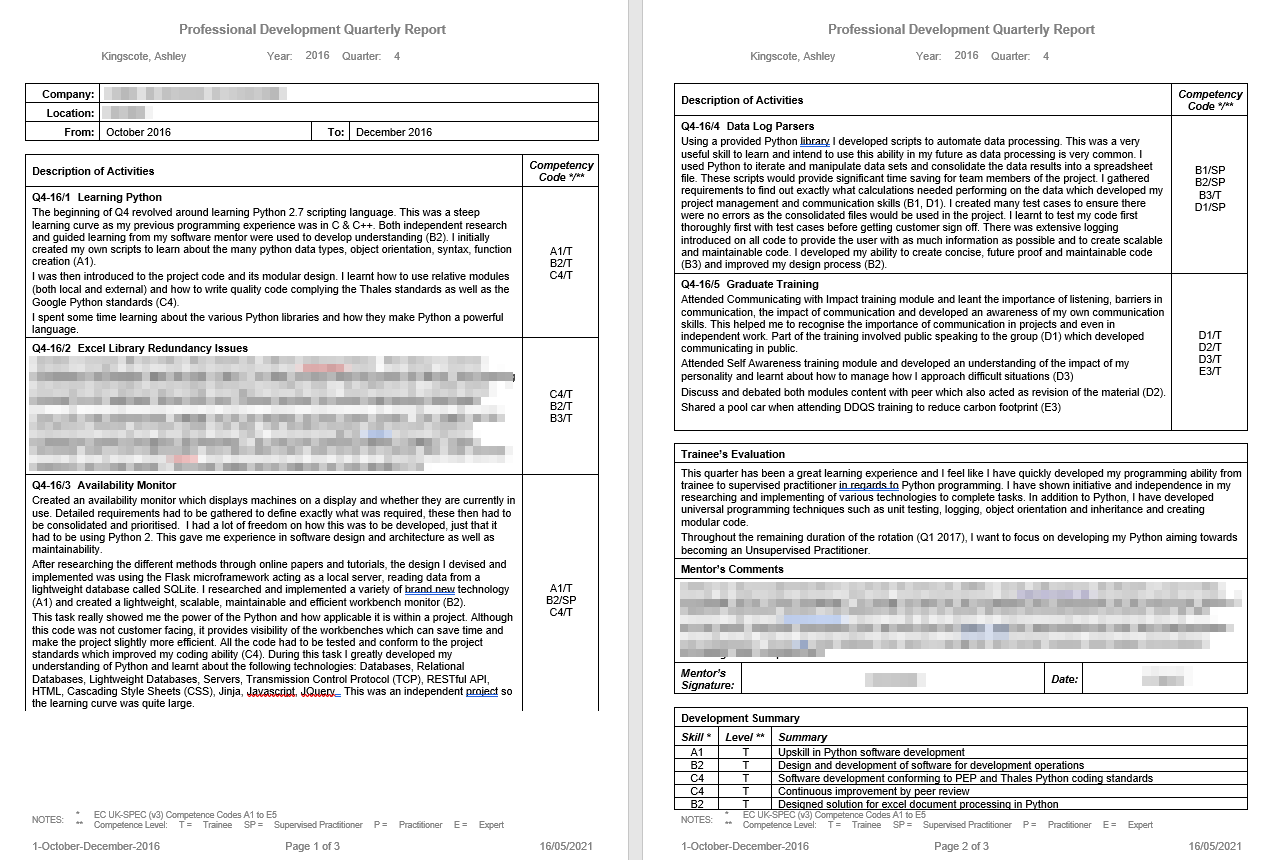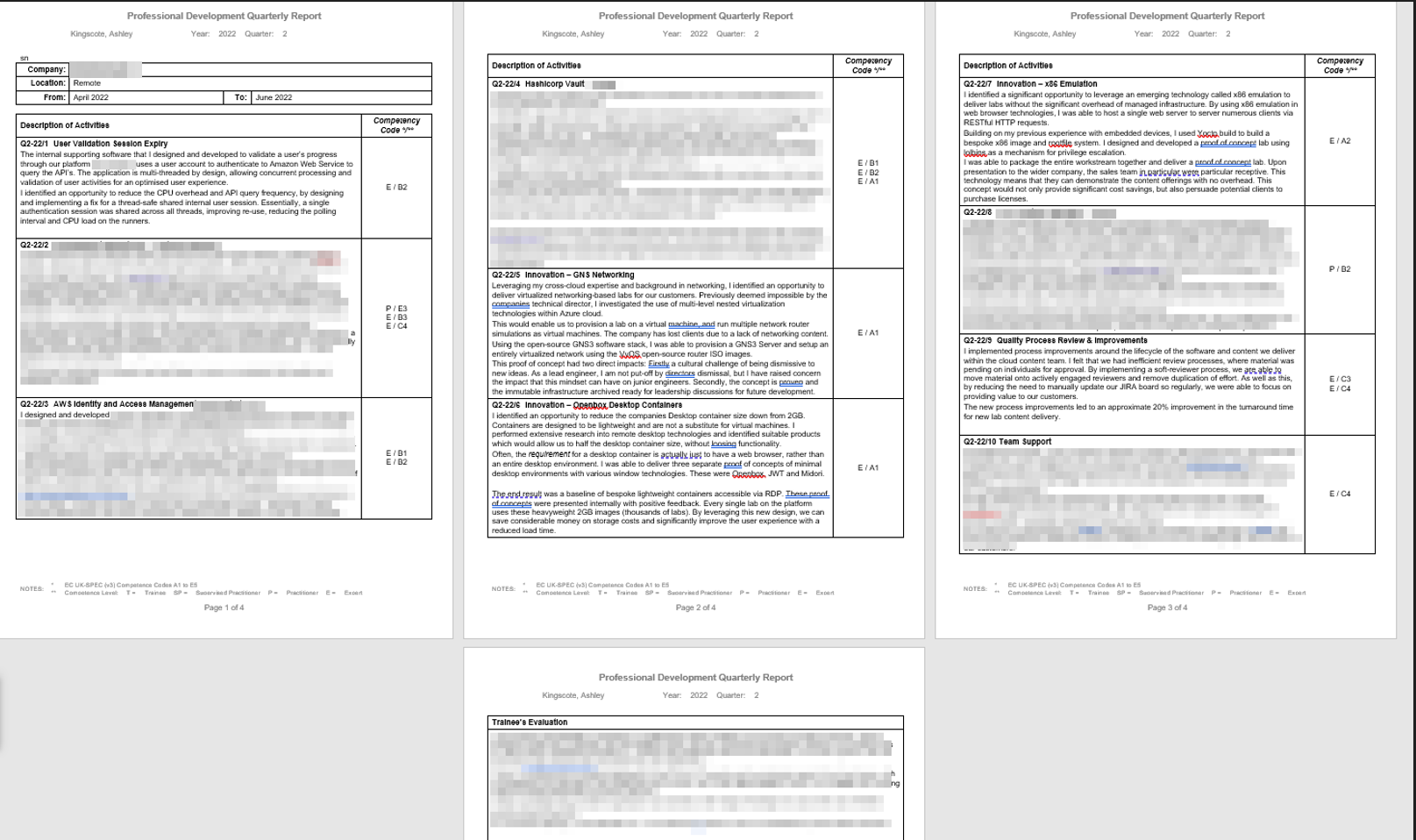Chartered Engineer (CEng) Reflection
I have recently been awarded CEng status from the UK Engineering Council through the international Institution of Engineering & Technology (IET). CEng status is something I’ve been working towards for a fair few years and i figured i’d write up my journey to achieve the status.
I started my career in 2016 (6 years ago) and have actively been working towards chartership since then. When i say actively working towards it, I mean actively working towards it. Working in an engineering environment within the defence industry, i was fortunate to receive some guidance very early on in my career. Essentially, with CEng as a goal - make sure i was working towards adequate coverage of the competencies.
I created a program called dearDiary, which creates a templated markdown file whenever i start my work PC up. I then document my day in this file. As a result, i have an exhaustive log of my day-to-day activity throughout my six year career. I can tell you with accuracy, what activities i did within a given day. Every three months (once a quarter), i would write a quarterly report and articulate my work aligned with the IET competencies. Something to be careful of is to not document proprietary information - so you can take your notes with you.
My early reports are all around the Trainee (T) competency level, but as I progressed my career throughout the years, my reports show my journey in competence through Supervised Practicioner (SP), Practicioner (P) and eventually Expert (E) in some fields.
Every time i documented a competency in my quarterly reports, i would also log in a Competency Evidence Record. When i had a strong coverage of competencies at Practitioner and Expert levels, I engaged took the IET self assessment.
I then asked for a mentor to be provided, as i didnt have anyone suitable within my professional network due to moving roles. I created a draft application report as per the guidance provided by the IET. The mentor i was originally assigned an individual who was not particularly responsive which i found quite frustrating. As with the format of my quarterly reports, i was often embedding competencies after a statement.
For example: “I prepared and presented material to senior stakeholders (D1, D2). The presentation….”
My mentor advised to not structure the report like that, but to rather make each statement only reflect one competency. So after some significant rework, i prepared my application for another informal review. It was a couple of weeks between emails and i was getting frustrated. After a while, i complained to the IET and eventually a replacement was found. The replacement was very attentive and gave me some really valuable feedback. Frustratingly, it was suggested to not include the embedded competencies inside my report - but to let the assessors decide what competencies my statement meet. I distinctly remember them saying “you are doing yourself a disservice by only referencing one competency”. My takeaway from this is that each mentor is different and has their own preferences for structuring your application.
My application itself was around 5,500 words. I was advised not to make the application too long, as at the end of the day *somebody* has to read it. For me, writing the application was relatively straight forward as I had an excessive amount of appropriately formatted documentation to source from.
My mentor supported my application as did my line manager at work. I submitted the application and was told i was successful for an interview. I submitted the application in June 2022 and didn’t hear anything until November 2022. I only heard something after i chase up my application progress with the IET. After chasing them up, the next day my interview was scheduled for two weeks time. I didn’t have a lot of free time to prepare on such sort notice - but I’ve got a lot of experience in preparing presentations. I created just three slides: a slide introducing myself, a engineering story around competency A and an engineering story around competency B. I opened my presentation by saying “the way i see it, you are assessing me as an individual - so here is a bit of a background around myself, my education, my career progression and my certifications”. The next two slides were very obviously conforming to STAR format and looked pretty professional. They were kind of similar to this formatting. I openly mentioned that the slides are a bit in your face in terms of conforming to the STAR format. I was very conscious to not make my presentation a wall of text and i used flaticon.com to have artwork reflecting talking points.
I found the interview to be relatively relaxed and semi-informal. Its obvious its an interview and the interviewers are professionals. I didnt feel that there were any trick questions and i feel they were very engaged in what i had to say. They asked me one particularly difficult question around ethical resolution which i found difficult to answer.
Overall, the process took a frustratingly long time - especially as i put so much work into my application and gaining the experience. However, the process was positive and I feel in a good position to help others with their journeys to become a Chartered Engineer.



